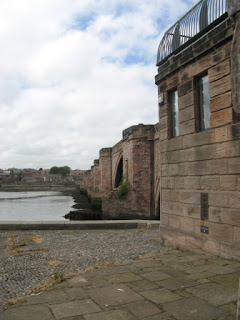I made it to the north of England and Hadrian’s Wall, taking photographs through the dirty windows of the buses and trains of the landscape.


I spent one night on the west end at Carlisle in a fabulous B&B. The price was right

(£27.50/night with breakfast) and the owners very accommodating and nice.


Although the room wasn't much bigger than a walk-in closet, the bed was comfortable and the food great. For my evening meal, I found a fabulous restaurant called Casa Romana, with amazing food that was not only delicious, but well presented.


The next night I stayed at a hostel halfway down the length of the wall at a place called Once Brewed (not far from the Vindalnda site). At £18.00/night (breakfast extra) it was a great deal and I managed to get my laundry done as well. I was sharing a room with five other women, all of us in bunk beds (the room held space for eight).
 The name of the place is a play on words from the neighbouring pub, which is called Twice Brewed. Apparently, many years ago the beer being served in the pub was so weak t
The name of the place is a play on words from the neighbouring pub, which is called Twice Brewed. Apparently, many years ago the beer being served in the pub was so weak t he local clientele told the publican that it needed to be brewed a second time, hence the name derived as Twice Brewed. Then many years later, a tee-totalling woman decide to start a youth hostel nearby and was known to have said that once brewed tea was all she needed, and hence the name Once Brewed was born. The two establishments are about 200 yards apart.
he local clientele told the publican that it needed to be brewed a second time, hence the name derived as Twice Brewed. Then many years later, a tee-totalling woman decide to start a youth hostel nearby and was known to have said that once brewed tea was all she needed, and hence the name Once Brewed was born. The two establishments are about 200 yards apart.
I caught a great bus (AD122) that travels several times a day from one end to the other of Hadrian's Wall. You can get off and explore one of the sites, then get back on and continue to the next site. The road criss-crosses the wall and sometimes you are right up beside it and at other times, it is quite a distance off. There is so much to see at each spot, however, that seeing everyone would take several days. Some people walk the entire wall, though I believe this takes about six days. 
I’ve also come across people who are walking the Penine Way (289 miles)….the backbone of England. It takes about 20 days…not my cup of tea! The Brits are great walkers everywhere and there are walking trails, footpaths, etc. so you can hardly avoid walking.  I’ve done quite a few miles in
I’ve done quite a few miles in  just the short time I’ve been here, but nothing like these excursions.
just the short time I’ve been here, but nothing like these excursions.
 At the Roman Vindalanda, there are amazing remains of buildings, and a couple of reconstructed towers so that people can see what they might have looked like and how tall the wall probably was. There were also serious ditches dug on the exterior or the wall was built on high cliffs, so it wasn't that easy to cross, as I'd first suspected.
At the Roman Vindalanda, there are amazing remains of buildings, and a couple of reconstructed towers so that people can see what they might have looked like and how tall the wall probably was. There were also serious ditches dug on the exterior or the wall was built on high cliffs, so it wasn't that easy to cross, as I'd first suspected.











































































